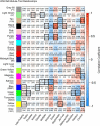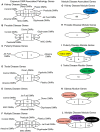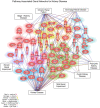Environmental induced transgenerational inheritance impacts systems epigenetics in disease etiology
- PMID: 35440735
- PMCID: PMC9018793
- DOI: 10.1038/s41598-022-09336-0
Environmental induced transgenerational inheritance impacts systems epigenetics in disease etiology
Abstract
Environmental toxicants have been shown to promote the epigenetic transgenerational inheritance of disease through exposure specific epigenetic alterations in the germline. The current study examines the actions of hydrocarbon jet fuel, dioxin, pesticides (permethrin and methoxychlor), plastics, and herbicides (glyphosate and atrazine) in the promotion of transgenerational disease in the great grand-offspring rats that correlates with specific disease associated differential DNA methylation regions (DMRs). The transgenerational disease observed was similar for all exposures and includes pathologies of the kidney, prostate, and testis, pubertal abnormalities, and obesity. The disease specific DMRs in sperm were exposure specific for each pathology with negligible overlap. Therefore, for each disease the DMRs and associated genes were distinct for each exposure generational lineage. Observations suggest a large number of DMRs and associated genes are involved in a specific pathology, and various environmental exposures influence unique subsets of DMRs and genes to promote the transgenerational developmental origins of disease susceptibility later in life. A novel multiscale systems biology basis of disease etiology is proposed involving an integration of environmental epigenetics, genetics and generational toxicology.
© 2022. The Author(s).
Conflict of interest statement
The authors declare no competing interests.
Figures







References
-
- BD 2013 Risk Factors Collaborators et al. Global, regional, and national comparative risk assessment of 79 behavioural, environmental and occupational, and metabolic risks or clusters of risks in 188 countries, 1990-2013: A systematic analysis for the Global Burden of Disease Study 2013. Lancet. 2015;386:2287–2323. doi: 10.1016/S0140-6736(15)00128-2. - DOI - PMC - PubMed
Publication types
MeSH terms
Grants and funding
LinkOut - more resources
Full Text Sources
Molecular Biology Databases

